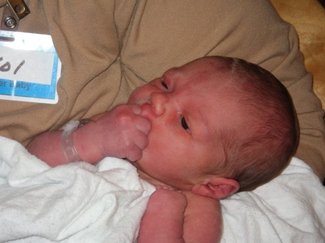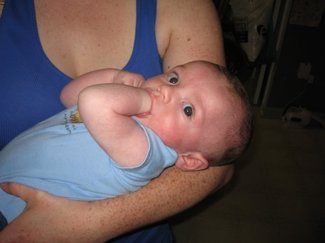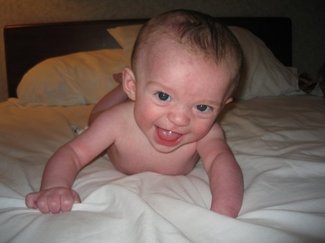Grieving “Perfection”
A couple months ago, Quinn emailed me with a topic suggestion for Bounce Back — a topic that was near and dear to her heart, a topic that NONE of the pregnancy or baby books covered, a topic that a lot of parents probably don’t even want to think about — birth defects. They happen. What do you do when it happens to you, to your baby? How do you deal with something that can color your entire birth and postpartum experience with your newborn…without letting it color your entire birth and postpartum experience with your newborn?
And so I wrote back and said yes! I think that is a fantastic, often-overlooked topic for new parents. Now help me write it.
Not only did Quinn offer to share her story of Baby Griffin and his “lucky fin,” her husband Steve went ahead and answered my questions as well. I’m going to tell you right now: I think this is the best post yet, and I can say that because I didn’t actually write it — I just handed the reins over to a fantastic couple of people. It’s a long but worthy read, I promise.
AMY: Okay, so first up: details. Tell us a little about your son and what happened at his birth.
QUINN: Griffin was born with a unilateral hand malformation due to failure to form. He doesn’t have a left hand, just a wrist and five little nubbins. We don’t know why. Arms grow out from the torso, lengthening and then splitting into fingers. For some reason his left arm just stopped growing after the wrist, although it still split and formed the nubbins. We know it’s not inherited, or related to any other idiosyncrasies, or due to anything I ingested or was exposed to. It just happened.
We didn’t know about this before he was born. We’d had a pretty uneventful pregnancy. We did the triple and quad screenings and the standard twenty week anatomy check, like most people. We’d skipped the amnio and CVS because I’m under thirty and neither of us has a family history of chromosomal disorders. We’d been planning on getting a for-fun 3D ultrasound, but we switched from an OB to a midwife in the beginning of the third trimester and I was laid off and it quite simply fell off the bottom of the to-do list. A 3D ultrasound might have shown the malformation…but it also might not have. Ultrasounds aren’t perfect.
I started getting a little borderline preeclamptic towards the end, but I went into labor spontaneously at the end of the 38th week and did the whole no meds, water birth, damn hippies thing. I was in a hospital because my husband and I liked the whole idea of nearby ORs and incubators.
I noticed his hand kind of in waves. He was in front of me, screaming, and one of the midwives was yelling to hold him in the water but to keep his head above the water, and my brain was shattering at the idea that this was my son in front of me. I suddenly thought that I needed to count his fingers and toes because it was tradition…and I kept getting hung up after the first five fingers. Eventually I realized that he only had five fingers.

AMY: I can’t even imagine all the emotions you must feel in those first moments — we all want to immediately declare our babies “perfect” and “beautiful” and so I’m guessing there was a certain degree of…disappointment? Guilt over that disappointment? Something akin to the seven stages of grief?
QUINN: I’m really glad that you’re referring to the grief stages, because that’s exactly what it is. You’re grieving the idea of the perfect baby, the baby you expected. No baby is perfect, but we’re allowed to think most newborns are because we don’t know them yet. When you have a baby with a birth defect you have that illusion ripped away from you pretty roughly.
After it sunk in, I had some really confused, dark emotions. I loved him, but…that wasn’t the overriding emotion. There was regret, and a lot of disappointment. And there was a lot of fear. Fear that he wasn’t well, fear that I was going to be a special needs mommy. I didn’t want to be a special needs mommy. I didn’t think I had it in me.
I became TERRIFIED that this was the tip of the iceberg. That there was something terribly wrong with his brain or his internal organs. I could almost hear our Mystery Diagnosis voiceover: “Griffin Matuszek was born without a hand. DOOM.” The pediatricians all said his heart and lungs sounded normal and he was peeing and pooping fine, but that was all they would say–they just didn’t know anything more. I felt like we were handed our baby and told he was one-handed but perfectly healthy! They think. Maybe. Go ask someone else.
The next few days were pretty intense. We held up pretty well in front of people, but when they left we fell apart. I was determined not to cry in front of anyone except my husband–I was afraid they would think I was a terrible mother who didn’t love her baby–so I spent all the time I should have spent sleeping crying instead.
I also blamed myself for making him wrong. I was worried my in-laws, who are wonderful people so this is ridiculous, would hate me. It took me a long time to get through that. Ultimately it wasn’t until I got reassurance from a whole bunch of doctors and reputable websites that it wasn’t my fault, that this just HAPPENS, that I really began to believe it.
STEVE: It isn’t akin to the seven stages of grief, it IS the seven stages of grief. We grieved for the hypothetical perfect baby who died when he was replaced with the baby we actually got.
Someone would explain that to us later, but I think I had already figured it out when I caught myself in the bargaining phase. I’m agnostic, so I had no one to bargain with and nothing to offer, but there I was sitting alone in the car in the parking lot (where Quinn wouldn’t see) sobbing my eyes out and begging desperately for the hand to be the only thing wrong, for him not to have a hole in his heart, not to be mentally retarded.
It would be a day or two before we were reasonably assured that there was nothing else wrong with his body, and much longer before he (or any baby) would start doing the things that indicated that his brain was functioning normally. So fear was the strongest emotion for me.
AMY: How did you tell people? Did you tell people first thing or wait awhile? Did anyone say something unintentionally terrible before they knew, like that “10 fingers and 10 toes?” question people always say in kind of a joking way? How did you handle stuff like that?
QUINN: Well, we’re geeks with Facebook and Twitter accounts, so…we made a webpage. My husband dashed together a simple text page announcing Griffin’s birth and linking to Flickr, and included a simple warning that he had one hand but was otherwise healthy. We didn’t want people to feel they couldn’t mention it, but we also didn’t want to draw too much attention to it.
I texted my close friends and family. I sent one text saying that he was born and all was well, and followed it up saying that he had one hand.
AMY: How did you feel about taking photos and/or seeing the defect in photos? Were you ever tempted to crop it out or did you feel it was important to really photograph your son as he was?
QUINN: I was pretty adamant that I wasn’t going to hide it from the start. Although…I didn’t exactly mention it in the email to my former coworkers, and the best picture just HAPPENED to have his hand tucked up under his chest. Ultimately it IS important to accept the birth defect, but it’s okay to give yourself time to process things.
STEVE: We told people immediately. I told my family and my boss via instant message and my best friends and coworkers via e-mail, all before leaving the delivery room. It didn’t occur to me not to.
No buildup, just “He was born with an undeveloped left hand.”
These two questions sort of have the same answer, because we had our smartphones, and a laptop in the hospital room, and people were going to expect pictures in e-mail and on Facebook right away anyway.
It did make me feel queasy to look at the hand, back then. It really does take some getting used to. So I kind of liked the photos where you couldn’t see it and you could think he was normal. But I recognized that feeling as a dead end and refused to act on it.

QUINN: You know, sometimes this is still a little hard? Griffin attracts a lot of attention in public places–all babies do. When someone’s waving at him or talking with me about him there’s a little part of me that’s always wondering if they’re thinking about his hand. My husband and I actually LOVE it when someone mentions the hand. It’s such a relief to not have to wonder.
Amazingly, we have not gotten a single bad comment. No one has asked if I drank or took drugs. Weirdly, a lot of people think it’s adorable. Children are the best–they’re curious about it, but then that’s it. They’re more interested in playing with him, just like they would with any other baby. I haven’t yet decided whether this is because people are just a lot better than I expected, or if I owe one hell of a thank you note to Disney for producing Finding Nemo.
STEVE:I feel like everyone we know took it in stride. We wanted to talk about the hand and they were all Yeah, whatever, look how adorable! You made an actual tiny person!
We make a lot of jokes, like, “Well, we figure he’ll only be half as grabby as other babies.” and “He may be missing that part, but we didn’t circumcise him, so he’s even with most boys.”
As far as strangers, it’s a breath of fresh air when people actually mention it and we can talk about it. If they don’t, then we feel like they’re just looking and wondering.
Surprisingly, we’ve found that a lot of people don’t even notice it, or it takes them a long time to do so. A grandmother at a barbecue that I took him to took half an hour to notice it, and she was holding him for the last 10 minutes of that! Humans really do fixate on each other’s faces, it seems.
AMY: What things helped you work through the emotions and get to the “acceptance” stage? What set you back? How are you, like, NOW?
QUINN: I won’t lie–I’m still sad sometimes. I wouldn’t trade Griffin for the most perfectly-formed child in the history of the world. But I’d move heaven and earth if it would get him a second hand.
Ultimately, getting answers helped. It helped to hear from doctor after doctor that this was an isolated thing. It helped to hear that I didn’t cause it. It also helped that Griffin started hitting milestones, developing appropriately and growing like some sort of weed child. I hate saying this because the thing I wanted most in the hospital was some damn answers, but that simply wasn’t possible right after he was born.
I wish that more pregnancy and parenting books had information about this sort of thing. Three percent of all babies born in the US have some sort of birth defect, and 70% of them have no known cause. (The CDC has a great webpage on this.) We’ve been amazed at how many people have talked to us about family members or friends who have birth defects–in fact, we learned that the wife of my husband’s oldest friend was inexplicably born without eyes. Fortunately most of these are minor and easily fixed–webbed fingers and toes, holes in the abdominal wall–but they still occur, and there’s simply no known reason. And yet, none of the books I read mentioned that. They were all Fetal Alcohol Syndrome! Unpasteurized cheese! It’s ALL YOUR FAULT!
It also helped to get some perspective. Shortly after Griffin was born, we found out that one of the twin daughters of a childhood friend of my husband’s, Sweet Baby Zane (sweetbabyzane.com) was diagnosed with Type 1 Spinal Muscular Atrophy (SMA). The disease is always fatal within a year or two, and she was just a month older than Griffin. She passed away a little over a month ago. This has had a huge impact on me. Griffin has one hand, and there is nothing I can do about that–no treatments or surgeries. That’s a big deal. But at the same time, it’s really, really not.
STEVE: Finding Nemo. Jim Abbott. And Sweet Baby Zane. I know Quinn is talking about her, so I’ll just add that I’d like to point people to http://sweetbabyzane.com/ to learn more about SMA and how to help find a cure.


